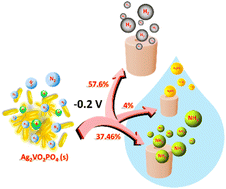Sustainable ammonia synthesis through electrochemical dinitrogen activation using an Ag2VO2PO4 catalyst†
Abstract
Ammonia (NH3) is the second most produced chemical commodity with a worldwide production of 235 million tonnes in 2019, by virtue of its importance in fertilizer production, energy storage and transportation, and in the production of industrial chemicals. The most frequent method of NH3 production in large plants (1000 to 1500 t day−1) is the Haber–Bosch process, which has drawbacks of high greenhouse gas emissions (2.16 tonnes CO2 per tonne of NH3) and high energy consumption (over 30 GJ per tonne of NH3) due to high pressure and temperature conditions. For sustainable NH3 production, we require alternative green routes, wherein the electrochemical route holds huge potential due to reduced energy consumption and plant costs, higher selectivity, lower temperatures and pressures, and small to medium scale utilization of NH3. However, there are a number of challenges faced during the same viz. low production rates due to difficult N2 activation and reduced faradaic efficiency due to competing side reactions in aqueous electrolytes. Therefore, the most crucial aspect of electrochemical ammonia production technology is the design of an electrocatalyst which could activate the strong N![[triple bond, length as m-dash]](https://www.rsc.org/images/entities/char_e002.gif) N triple bond and effectively suppress the competing hydrogen evolution reaction (HER). In addition, the true NH3 yield estimation is of major concern due to the presence of possible N-contaminants, which may possibly lead to false estimation or overestimation of NH3. In this context, we have synthesized an Ag2VO2PO4 electrocatalyst with rice-grain like morphology via an energy efficient and less time consuming sonochemical method to carry out low temperature NH3 synthesis in an alkaline electrolyte. The choice of Ag metal and an alkaline environment effectually suppresses the HER and the bimetallic phosphate materials (Ag and V metals) induce high activity during nitrogen reduction, while rigorous analysis for tracing/elimination of N-labile and reducible species is considered for true NH3 production and assessment.
N triple bond and effectively suppress the competing hydrogen evolution reaction (HER). In addition, the true NH3 yield estimation is of major concern due to the presence of possible N-contaminants, which may possibly lead to false estimation or overestimation of NH3. In this context, we have synthesized an Ag2VO2PO4 electrocatalyst with rice-grain like morphology via an energy efficient and less time consuming sonochemical method to carry out low temperature NH3 synthesis in an alkaline electrolyte. The choice of Ag metal and an alkaline environment effectually suppresses the HER and the bimetallic phosphate materials (Ag and V metals) induce high activity during nitrogen reduction, while rigorous analysis for tracing/elimination of N-labile and reducible species is considered for true NH3 production and assessment.

- This article is part of the themed collection: Sustainable nitrogen activation


 Please wait while we load your content...
Please wait while we load your content...